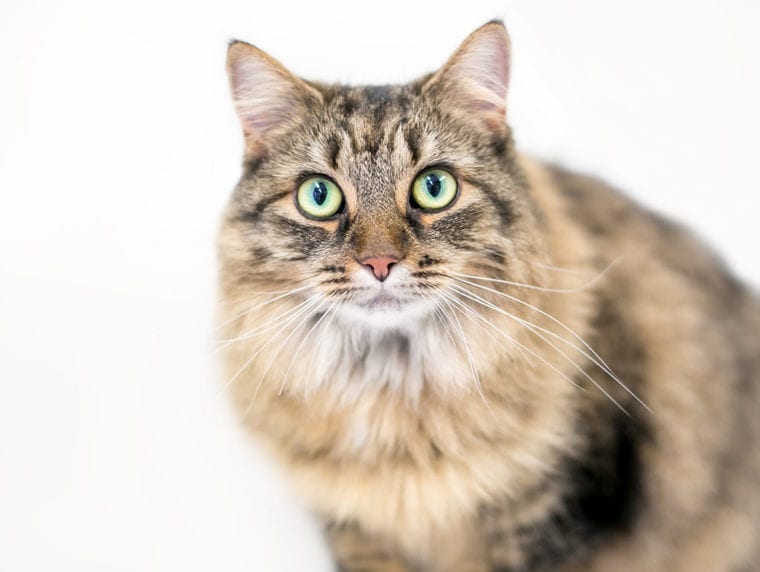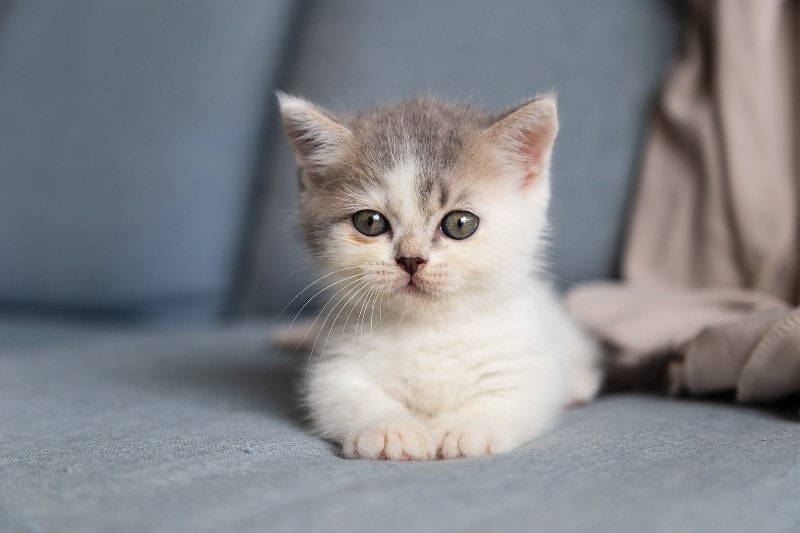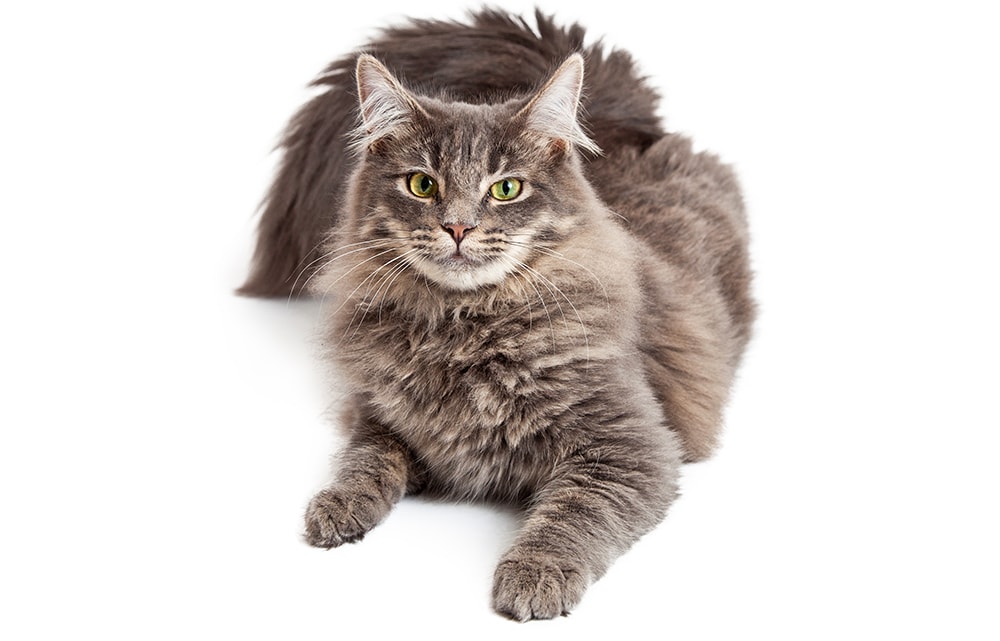
Click Below to Skip Ahead
Domestic Medium-Haired cats (DMH) are sometimes known as the mutt of the feline world. Don’t think of DMH as a breed, as they’re technically not a single breed. Instead, the term DMH refers to a specific type of cat with a medium-length coat that comes from a wide variety of other breeds.
Breed Overview
Height:
9–14 inches
Weight:
11–22 pounds
Lifespan:
15–17 years
Colors:
All the colors of the kitty rainbow
Suitable for:
Households with children and other pets, first-time pet owners, those who don’t have their heart set on any particular look or temperament
Temperament:
Playful, energetic, friendly, independent, reserved, shy
DMH cats run the gamut in both appearance and temperament. You can find a DMH with an orange tabby pattern that’s loyal and loving just as easily as you can find a tortoiseshell DMH who prefers peace and solitude.
If you’re wondering if a DMH is the right kitty for your household, let us help you make that decision. Keep reading to learn everything you’ve ever wanted to know about these beloved mutts of the cat world.
Domestic Medium-Hair Cat Characteristics
Domestic Medium Hair Kittens

Domestic medium-haired kittens are not an exceptionally rare breed. They may be slightly more difficult to find than their long- and short-haired cousins, but the chances are that there’s an adoption shelter in your area with a DMH kitten waiting for you. Since they’re not a pedigree breed, your fees to adopt one will likely be on the lower end of the spectrum.
The temperament of a Domestic medium-hair cat is hard to predict. They can be very friendly and playful, but also shy and independent. They are generally healthy and with enough love and care, they should grow into happy and healthy cats.
Temperament & Intelligence of the Domestic Medium Hair Cat
Since the gene pool of this breed is so big, it is impossible to provide a temperament and intelligence description that suits every domestic medium-haired cat. Every cat of this breed will have its own personality traits.
One DMH in a litter of kittens might grow to be shy, reserved, and independent, while another kitten from that same litter might be sociable, loving, and outgoing.
Early training and socialization can help timid DMH become more tolerant towards their human family members. This isn’t a guarantee, however. Some cats are born the way they are and will never change their personality regardless of how much they’re socialized.
Are These Cats Good for Families? 👪
Absolutely. The DMH cat is a great pet for households with children. As kittens, most DMH cats are very playful and easy to get along with. As long as your children can understand boundaries and know when to stop when their cat is done playing, they should get along just fine.
Of course, it is always best to begin the socialization journey when your cat is as young as possible. When they grow up around children, chances are they’ll be more patient and tolerant than if they first meet a child when they’re a full-grown adult cat.

Does This Breed Get Along with Other Pets?
DMH cats can get along with other cats and dogs, provided that they’re introduced when they’re young. It is still possible for your DMH to live harmoniously with other household pets if you adopt them when they’re older, but you must introduce them to one another slowly over a few weeks. The more patient you can be, the higher the chances of success. Your pets need to get used to the scent of one another before they even lay eyes on each other. You’ll also need to provide supervision during the first few meetings to ensure the safety of all your pets.
Things to Know When Owning a Domestic Medium Hair Cat:
Food & Diet Requirements 🐡
There are no specific nutritional needs for the DMH based solely on their breed. Like all other cats, DMHs thrive on a balanced diet that’s packed with protein and other essential vitamins and minerals.
Cats are obligate carnivores which means they need nutrients that can only be found in animal products. Look for commercial cat foods that list real meat as the first ingredient. The following four ingredients should also be high-quality as they will be found in higher quantities in your cat’s food than items found lower on the ingredient list.
If your DMH has certain health conditions, you should inquire with your vet to learn what the best diet will be for their specific needs. Cats who are overweight, for example, will need a calorie-controlled diet to prevent obesity. Those who are diabetic will need a diet higher in protein and lower in carbohydrates.
- You might want to check out: 14 Best Cat Food Bowls: Reviews & Top Picks
Exercise 🐈
Exercise is an important component of cat care that a lot of owners don’t think about. Not only does physical activity satisfy your cat’s natural hunting instincts, but it’s great for keeping them at a healthy weight and ensuring they have a healthy outlet for their energy levels.
Many DMH cats are playful and energetic, though not all of them will have these personality traits.
Every household with cats should have at least one cat tree for their kitties for climbing and playing purposes.
You should also invest in a few different kinds of cat toys to see which work best with your cat’s personality. Some love feather wand toys, while others go buck wild for springs or balls. Some will turn their noses up at electronic toys, while others can’t get enough of them.
Set aside a few minutes every day to play with your cat, especially if they don’t have a playmate in other household pets.
Training 🧶
DMH cats can be highly trainable, but not all of them are. Their trainability will depend on their individual personality traits. If you happen to adopt an easygoing and excessively intelligent DMH kitten, you’ll find that training them shouldn’t be very difficult. They can learn to play fetch and perform other tricks with the right motivation (hint: treats).
If you find your DMH cat isn’t as easy to train as you expected, don’t give up. Even the most stubborn of cats can be trained with a little (or a lot of) patience.
Grooming ✂️
The grooming needs of the DMH cat are not as demanding as they are for their long-haired cousins, but you will still need to perform your duties as a cat parent by assisting them with grooming weekly.
Since DMHs have a thick, double coat, they’ll need to be brushed at least once a week to prevent tangles, skin irritation, and fur matting. You may need to commit to more regular brushings during shedding season.
Proper grooming can also reduce how many hairballs your cat ingests. Hairballs aren’t only an inconvenience for you, but they can pose a serious health threat if they grow too large and cannot be regurgitated.

Health and Conditions 🏥
Unlike some pedigreed cat breeds, the “mutt” domestic shorthair cat is not prone to any particular health condition specifically based on their genetics. As with any other cat breed, though, there are some conditions you should be on the lookout for.
Obesity is an extremely common condition in cats with an upwards of 50% of cats between five and 11 considered to be obese. Luckily, this is one health condition that is entirely preventable. When given unlimited access to food, many DMH will wind up consuming much more food than they need. Obesity can shorten your cat’s lifespan as well as put them at risk of serious health conditions like cancer, diabetes, and osteoarthritis.
Chronic Kidney Disease (CKD) is another common ailment often seen in older cats (+7 years). Estimates suggest that around over the age of 15 will develop symptoms of CKD. This condition is progressive and begins with subtle and mild symptoms that can often go unnoticed. As it worsens, you might notice your kitty is losing weight, excessively thirsty, urinating often, and not eating as much.
Hyperthyroidism is another somewhat common condition that is often diagnosed in older cats. It affects up to 10% of the feline population over age 10. It occurs when there is an overproduction of your cat’s thyroid hormone. Symptoms of this condition include weight loss, hyperactivity, matted coat, and increased vocalization. Hyperthyroidism can cause high blood pressure and heart disease.
Other health conditions you may need to be on the lookout for in your DMH cat include
Male vs Female
The biggest difference between male and female DMH cats is that males are often larger in stature and heavier than their female counterparts. This is not a DMH-specific trait, as male cats of all breeds tend to be bigger than females. Regardless of gender, DMH cats tend to be medium in size with a muscular build. Their heads are slightly angular, and ears are pointed and upright.
Gender doesn’t dictate temperament or personality traits, so we don’t recommend basing your adoption solely on the gender of your pet.
3 Little-Known Facts About the Domestic Medium-Hair Cat
1. The Domestic Medium Hair Has a Mixed Ancestry
The DMH cat is essentially the combination of many different cat breeds from all around the globe and isn’t technically considered a breed. The DMH cat has gone through generation after generation of mixed breeding to achieve the look they have today. If you were to DNA test your DMH cat, the chances are that you’d find many breeds in their bloodline.
It is this mixed ancestry that makes it difficult to provide an exact temperament, intelligence, appearance, or personality description. Since their ancestors are a wide variety of different breeds, modern DMHs come in all colors, patterns, builds, and no two will have the same personality traits.
2. They Have a Unique Gene That Causes Their Fur Length
The DMH has a unique gene in its DNA that gives it its luxurious, soft, mid-length fur. If it weren’t for this gene, the DMH would look very similar to the domestic shorthair. DMH cats have a thick, double coat that is easier to maintain than the coats of their long-haired cousins but requires more grooming than domestic shorthair cats.
3. The Pilgrims Brought the Breed Over
The introduction of the DMH cat to the United States is traced back to the early 1600s. The Pilgrims brought the ancestors of the DMH over on the Mayflower as a means of deterring the rampant rodent population on their ships. These kitties were also tasked with the job of protecting food and keeping the ships’ passengers safe from rodent-borne diseases.
Final Thoughts
Domestic medium-hair cats are beautiful and unique in a lot of ways. Their physical appearance and character traits will vary greatly from cat to cat, so you truly never know what you’re going to get when a litter of DMH kittens is born. The unknown is part of what makes owning a DMH so exciting.
These cats are great for families with children and other pets, so long as you have the patience to introduce them slowly. They can be friendly and loyal lap cats who never leave your side or independent and reserved roommates who you share a household with and nothing more.
If you’re willing to roll the dice and aren’t afraid of the unknown when it comes to appearance and temperament, the DMH is a great, hardy cat with a lot to offer its owners. If you prefer to know what you’re getting yourself into, you might want to steer clear of this “mutt” of the feline world.
Featured Image Credit: Mary Swift, Shutterstock







